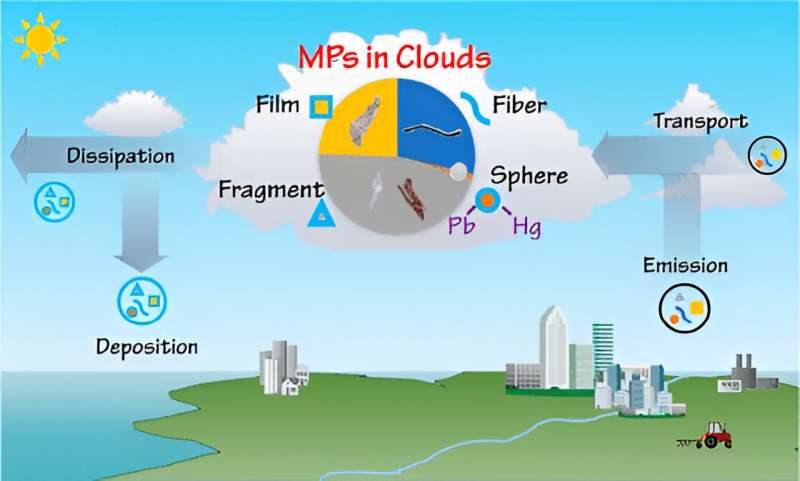Microplastics found in clouds could affect the weather
From the depths of the seas to snow on mountains and even the air above cities, microplastics are turning up increasingly often. Now, in Environmental Science & Technology Letters, researchers have analyzed microplastics in clouds above mountains. They suggest that these tiny particles could play a role in cloud formation and, in turn, affect weather.
Microplastics—plastic fragments smaller than five millimeters—originate from a myriad of items used daily, such as clothing, packaging and car tires.
As research in the field evolves, scientists are not only detecting microplastics in the atmosphere but also investigating how they may play a role in cloud formation. For example, a group of researchers recently detected plastic granules, which had water-attracting surfaces, in Japanese mountaintop clouds.
So, to learn more, Yan Wang and colleagues set out to look for microplastics in mountain clouds, used computer models to figure out how they could have gotten there, and tested how the particles could have impacted—and been impacted by—the clouds.
Wang and the team first collected 28 samples of liquid from clouds at the top of Mount Tai in eastern China. Then they analyzed the samples and found:
- Low-altitude and denser clouds contained greater amounts of microplastics.
- Particles were made of common polymers, including polyethylene terephthalate, polypropylene, polyethylene, polystyrene and polyamide.
- The microplastics tended to be smaller than 100 micrometers in length, although some were as long as 1,500 micrometers.
- Older, rougher particles had more lead, mercury and oxygen attached to their surfaces, which the researchers suggest could facilitate cloud development.
To investigate where the plastic particles in the clouds originated, Wang and the team developed computer models that approximated how the particles traveled to Mount Tai. These models suggested that airflow from highly populated inland areas, rather than from over the ocean or other nearby mountains, served as the major source of the fragments.
In laboratory experiments, the researchers demonstrated that microplastics exposed to cloud-like conditions—ultraviolet light and filtered cloud-sourced water—had smaller sizes and rougher surfaces than those exposed to pure water or air. Additionally, particles impacted by the cloud-like conditions had more lead, mercury and oxygen-containing groups.
These results suggest that clouds modify microplastics in ways that could enable the particles to affect cloud formation and the fate of airborne metals. The researchers conclude that more work is needed to fully understand how microplastics affect clouds and the weather.
More information:
Characterization of Microplastics in Clouds over Eastern China, Environmental Science & Technology Letters (2023). DOI: 10.1021/acs.estlett.3c00729. pubs.acs.org/doi/abs/10.1021/acs.estlett.3c00729
Citation:
A not so silver lining: Microplastics found in clouds could affect the weather (2023, November 15)
retrieved 15 November 2023
from https://phys.org/news/2023-11-silver-lining-microplastics-clouds-affect.html
This document is subject to copyright. Apart from any fair dealing for the purpose of private study or research, no
part may be reproduced without the written permission. The content is provided for information purposes only.

From the depths of the seas to snow on mountains and even the air above cities, microplastics are turning up increasingly often. Now, in Environmental Science & Technology Letters, researchers have analyzed microplastics in clouds above mountains. They suggest that these tiny particles could play a role in cloud formation and, in turn, affect weather.
Microplastics—plastic fragments smaller than five millimeters—originate from a myriad of items used daily, such as clothing, packaging and car tires.
As research in the field evolves, scientists are not only detecting microplastics in the atmosphere but also investigating how they may play a role in cloud formation. For example, a group of researchers recently detected plastic granules, which had water-attracting surfaces, in Japanese mountaintop clouds.
So, to learn more, Yan Wang and colleagues set out to look for microplastics in mountain clouds, used computer models to figure out how they could have gotten there, and tested how the particles could have impacted—and been impacted by—the clouds.
Wang and the team first collected 28 samples of liquid from clouds at the top of Mount Tai in eastern China. Then they analyzed the samples and found:
- Low-altitude and denser clouds contained greater amounts of microplastics.
- Particles were made of common polymers, including polyethylene terephthalate, polypropylene, polyethylene, polystyrene and polyamide.
- The microplastics tended to be smaller than 100 micrometers in length, although some were as long as 1,500 micrometers.
- Older, rougher particles had more lead, mercury and oxygen attached to their surfaces, which the researchers suggest could facilitate cloud development.
To investigate where the plastic particles in the clouds originated, Wang and the team developed computer models that approximated how the particles traveled to Mount Tai. These models suggested that airflow from highly populated inland areas, rather than from over the ocean or other nearby mountains, served as the major source of the fragments.
In laboratory experiments, the researchers demonstrated that microplastics exposed to cloud-like conditions—ultraviolet light and filtered cloud-sourced water—had smaller sizes and rougher surfaces than those exposed to pure water or air. Additionally, particles impacted by the cloud-like conditions had more lead, mercury and oxygen-containing groups.
These results suggest that clouds modify microplastics in ways that could enable the particles to affect cloud formation and the fate of airborne metals. The researchers conclude that more work is needed to fully understand how microplastics affect clouds and the weather.
More information:
Characterization of Microplastics in Clouds over Eastern China, Environmental Science & Technology Letters (2023). DOI: 10.1021/acs.estlett.3c00729. pubs.acs.org/doi/abs/10.1021/acs.estlett.3c00729
Citation:
A not so silver lining: Microplastics found in clouds could affect the weather (2023, November 15)
retrieved 15 November 2023
from https://phys.org/news/2023-11-silver-lining-microplastics-clouds-affect.html
This document is subject to copyright. Apart from any fair dealing for the purpose of private study or research, no
part may be reproduced without the written permission. The content is provided for information purposes only.
